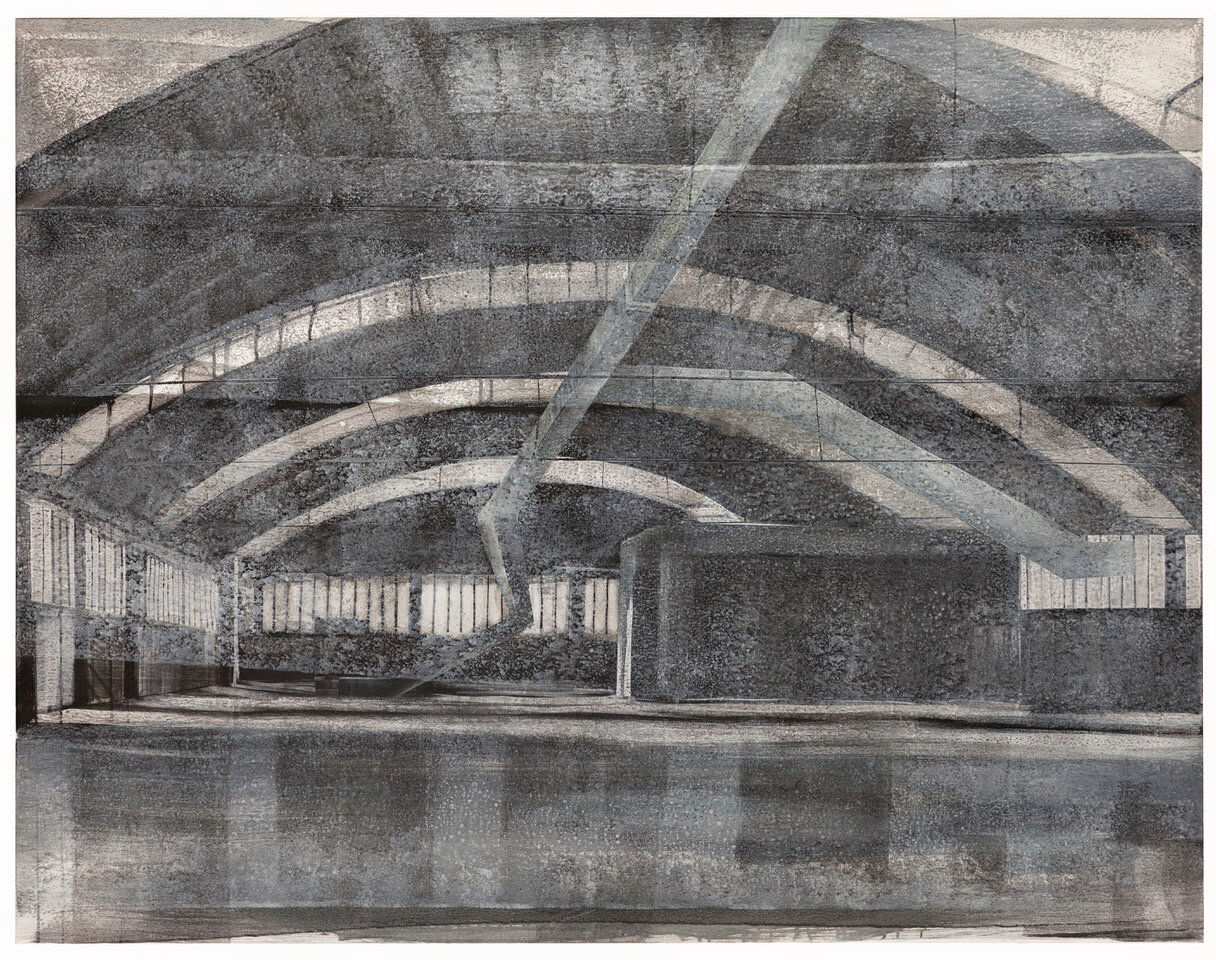Of Snow and Sorrow, the recent body of work by Serbian-American artist, Natalija Mijatovic, considers quiet voids, repetition, and memory. In our most recent installment of Artist Insights below, Mijatovic speaks in depth on her practice and artistic choices.
Natalija Mijatović in studio
Internally, I dwell in uninhabited residual landscapes of urban decay and gray facades of soc-realist architecture of Eastern Europe. I remember my previous life as a wintery silence of an empty city, ashes of the burnt home, and snow. The general theme of my work is the industrial landscape, and my recurrent interest is in manmade structures and objects defined by the quiet void of human presence. My approach is an amalgam of extracting visual shapes from their logical setting (electric power plants, wiring systems, factory interiors) taken out of context, yet realistically rendered and juxtaposing them against flat or sub-spatial backgrounds. The underlying grid system references industrial spaces with a rich history of human activity, alluded to through architectural forms. Multilayered veils of thin glazed surfaces reduce industrial structures to a residual patina that recalls space and time. This creates the idea of traces of human presence felt in the residue of the space’s emptiness. These traces are revealed in the subtle implications of representational imagery like wire, or wooden beams, and yet they are abstracted so that their presence borders on the surreal. A subtle linear system ties my entire oeuvre together: the structure remains intact beneath the curtain that the viewer navigates, recalling their own experiences and nostalgic inference associated with these now unoccupied industrial spaces and landscapes.
I am attracted to unknown spaces that have a “known” or “lived” quality for me, as if I remember them from some past life. As I look for reference images (some of which I find, most I make) I am guided by an instinctual feel of familiarity. Every ruin is a memory of a lost home, and in my case a lost homeland.
I often build up my spaces by painting them in detail, and then proceed to cover with numerous veils of transparent paint to pull some details up front again, mostly leaving it in a suggestive state of quiet presence. Obliteration and restoring - the notion of loss in terms of painterly language is related to the reduction in palette and absence of figuration. I think of the non-presence of people, rather than their absence. Non-presence seems more active in a way, it’s a space which is in a latent state. Absence is a space that is left behind. I think of spaces I create as a refuge or a quiet place for us to find a moment of reflection.
I labor carefully to maintain completely flat, smooth surface of the painting, which is why I gradually shifted from linen and canvas, to wood panel. The surface is smooth, and reflective like the surface of still water, or window glass. I cherish the paradox of flatness of the substrate and the medium, and depth of plane achieved via layering of veils.
Materiality vs. perception. Reality vs. memory. Physicality vs. spirituality. Formal elements are an important aspect of my creative investigation, such are the aforementioned considerations of palette, and composition, as well as tactile qualities of substrate and finished surface.
Alongside paintings on linen, canvas and wood panels, I continuously explore papers of various grammature, only to return to heavyweight paper, cold pressed, with relief-like texture. Each piece is a topography, or cartography. Upon touch, the surface of the paper is a landscape of its own. Unlike painting, with its wet stillness, paper’s dry expanse evokes landscapes of different temperature and light. The economy of mark and color is finely calibrated to follow reverberation of chosen substrate.
Repetition is deliberate. Both linear structures, built by repetitive horizontal and vertical lines as a grid (support, net, fabric, something that holds matter together), and dots of paint that are condensations of water, droplets of rain, snowflakes, or beads of sand, are a quiet, long repetitive activity. The dots hover over the surface creating their own grid. Surface of the painting is a frozen lake water.
I apply thin layers of paint, in a slow mourning ritual. Veiling of shrouds, as caring, preserving efforts to stop the decay. Melancholic and meditative, as countless small marks are being made, I am in a state of permanent prayer, mindful of the hand that makes the mark yet remains unnoticeable. I enjoy the fact that marks appear as if the weather made them, or ashes, or sand.
I am deeply committed to this path of materializing in mark and color the internal landscapes of memory and loss, a denouement of the visceral in matter.
I have exhibited internationally since 1999, and have participated in panel discussions, gallery talks, public lectures and other forms of professional practice and community engagement, including painting murals and workshops. The pace of my exhibition record is dictated by the demands of a meticulous and laborious process of painting. An integral component of my exhibitions are gallery talks, Q & A sessions with the audience, and other forms of exchange. My passion to personally connect with the audience through the profound impact of art is the driving force synergizing my creative research and teaching career.





